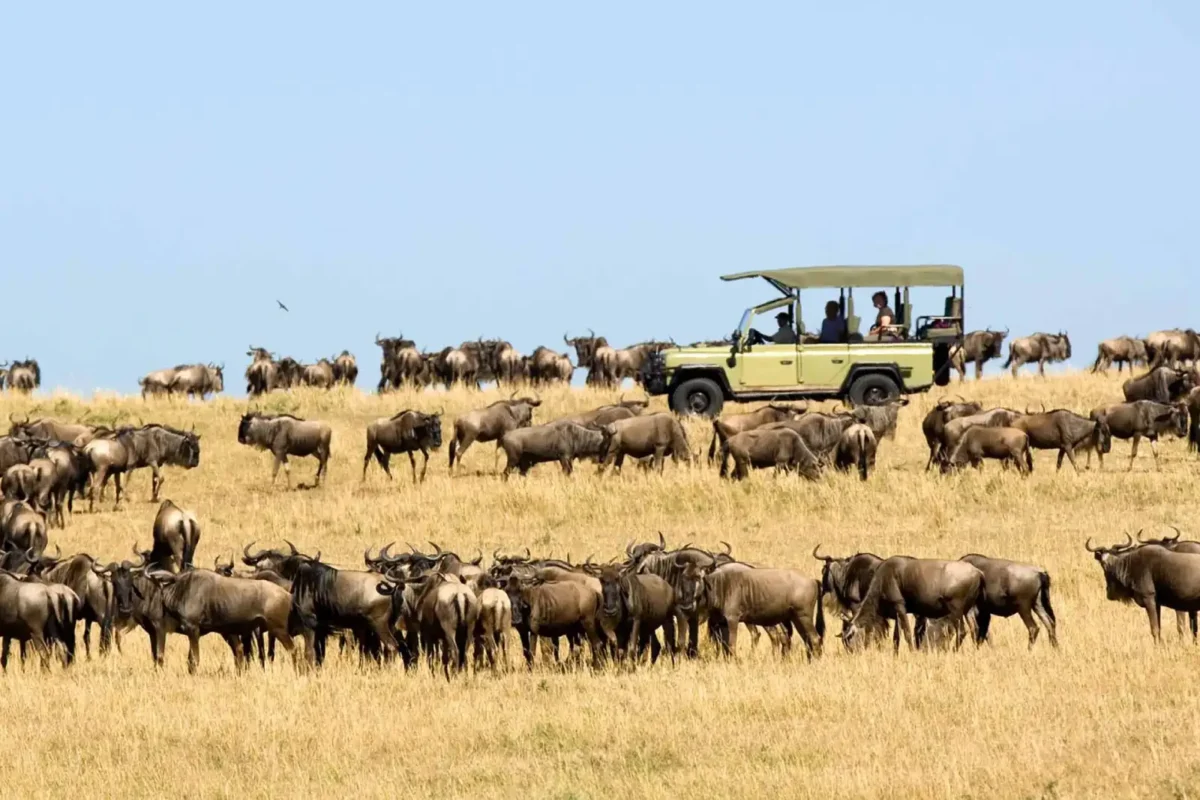Great Wildebeest Migration
Roam Free, See the Wild & Live the Safari

Great Wildebeest Migration
The journey for the key players in the Great Migration, the roughly two million wildebeest, starts in the south of the Serengeti, with the birth of half a million calves between January and March. A favorite season for many of the seasoned Serengeti guides: the air during these months is full of new life and action. Read all about Africa’s biggest wildlife event on this page.
Each year millions of wildebeest, zebra, and gazelle move across the Serengeti plains in search of green grass and fresh water. The southern and northern plains of the Serengeti are the two main feeding grounds for the herds. The animals are constantly on the move between these two areas each year. Their location can be roughly predicted at a given time of the year, although this is dependent on rainfall patterns.
The Great Wildebeest Migration – the annual migration of giant herds of grazers across Northern Tanzania and Kenya is a truly spectacular event. Over two million wildebeest, zebras, and gazelles move through the Serengeti and Masai Mara ecosystems in search of green pasture, in a regular pattern. This is surely one of the greatest wonders of the natural world.
Great Wildebeest Migration
The Serengeti National Park is famed for its Annual Great Migration
Why do wildebeest migrate in Serengeti & Maasai Mara Kenya?
Migration in a Nutshell -A better illustration of the circle of life probably cannot be found anywhere else in the world. The migration journey starts in Southern Serengeti when wildebeest calves are being born. Predators like lions and hyenas are constantly hunting for babies, and thousands and thousands of calves are born within a couple of weeks of each other – a feast for the eyes of true wildlife enthusiasts.
When the drought comes in May, the herd moves north, towards the Masai Mara in Kenya, chomping down the high green grass, quickly followed by the gazelles and zebras. The migration is not without risk: crossing rivers means facing about 3,000 crocodiles, patiently waiting for a kill. Not to mention the famous Serengeti lion population: by far the largest in Africa. Despite the abundance of hoofed meat in this area, life is not easy for these big cats in this unforgiving landscape. But seeing a group of lions collaborating to hunt down a wildebeest is an unforgettable sight.
Then, with the beginning of the short rains in late October, the migration makes its way back into the Serengeti. By December, the herds trek past Seronera – a small settlement in central Serengeti where the official Serengeti Visitors’ Centre is located – to return to their calving grounds again, and the circle is complete.
Detailed Great Migration Cycle and Map
We can find the main calving grounds in the area southeast of Seronera: typical Serengeti plains stretch to the Ndutu area near Ngorongoro. Triggering their move to this area are the short rains in November and December. The wildebeest stick around this area until the end of the long rains, the end of April, and early May. The delightful news is that this section of Serengeti National Park is easily accessible and that in this period the landscape becomes lush. February is usually the calving season in the Ndutu area and the southeastern plains: the very best time to visit this area. As wildebeest, zebra and other ungulates are so many and give birth to so many calves, the spectacle works as a magnet for predators. As early as March or April the herd may move again in search of greener pastures. Seeing the actual migration in this period is more difficult, but chances are that you will encounter very large herds on the move.
This is the period that the wildebeest, after having feasted on the short green grasses of the south-eastern Serengeti and after having given birth to their offspring, start getting ready for their 800-kilometer-long trek. The actual starting date may be anytime between late April and early June. This is the time you may have the privilege to see one of the greatest natural phenomena in the world: more than a million marching animals in a column up to 40 kilometers long. During the migration, the herd will move towards the Western Corridor, where they will face the first major obstacle: crossing the Grumeti River. Many animals don’t survive the crossing as they are being awaited by the area’s population of oversized crocodiles ready to feast. The herd may congregate on the southern bank of the river and stay there for up to two weeks before crossing the river.
When the Grumeti River obstacle has been taken, the herd moves further north and starts crossing the next big hurdle, the Mara River, in July or August. The Mara River crossing is where so many iconic Great Migration photos have been taken. After this crossing the herd flocks to the northwest plains and Masai Mara National Reserve in Kenya. The August – September period is the best time to visit Serengeti National Park and see the Great Migration as the herd moves into the Masai Mara in Kenya. This is an excellent time to stay at one of the Serengeti Mara camps so that you can easily witness the River Crossing.
Crossing the Mara River northbound means that, at one point, the herd needs to cross the river one more time before commencing the trek back in a southerly direction. This usually happens in October, but sometimes earlier. In this period the herd will cross the northern plains and Lobo area. This section of Serengeti National Park is lack Visitors, so if you are looking to see the migration in relative quietness, this would be the time. The wildebeest return to the short-grass plains and the calving ground around Ndutu in late November. And from here, the Great Migration starts all over again.
When is the best visit?
It is a matter of choice whether you would like to plan your Serengeti safari around the Great Migration. We have mentioned earlier that the Serengeti is a year-round destination as it covers a vast area and offers unparalleled wildlife viewing. Chances that you will be at the exact spot of the Great Migration herd crossing a river (either at the Grumeti or Mara River) are very slim. You can not guarantee to time them crossing. However, if you choose the right part of the Serengeti: the southeast and Ndutu from December through to May, the Serengeti Mara area from July through to October, and the northern Serengeti and Lobo area in October and November, large herds of wildebeest and their entourage should be easily located.
Frequently Asked Questions About Migration Safari
This is nature, so we’re never fully in control. Rainfall dictates the movement of the herds, so if the rains are early or late one year, this will have a knock-on effect on predicted timings. Climate change makes the rains less predictable than they once were.
While the migration is a year-round event, the most popular time to witness it is between July and October. This is when the herds are crossing the Mara River, offering breathtaking and dramatic spectacles. However, each season has its own unique charm.
The migration primarily occurs in the Serengeti National Park in Tanzania and the Masai Mara National Reserve in Kenya. These vast savanna ecosystems provide the perfect habitat for these animals.
The migration follows a circular pattern determined by rainfall and fresh grazing land. The herds move clockwise, starting in the southern Serengeti, then heading north towards the Masai Mara, and finally returning south.
The migration is a perilous journey filled with challenges. Predators like lions, cheetahs, and crocodiles pose constant threats. Crossing rivers, especially the Mara River, is a particularly dangerous ordeal. Additionally, the animals face the challenges of drought, disease, and exhaustion.
There are numerous tour operators offering safaris to witness the migration. Hot air balloon safaris provide a unique aerial perspective. Game drives allow you to get closer to the action. Remember to choose a reputable operator and be prepared for unpredictable wildlife encounters.
Our Reviews
Legacy Exchange Outfitters offers more than just a vacation. Eugene and his team work hard to provide their guests with a remarkable experience. However, sightseeing wild animals in their natural habitat is only part of the adventure.
Victoria Mayers – USA




